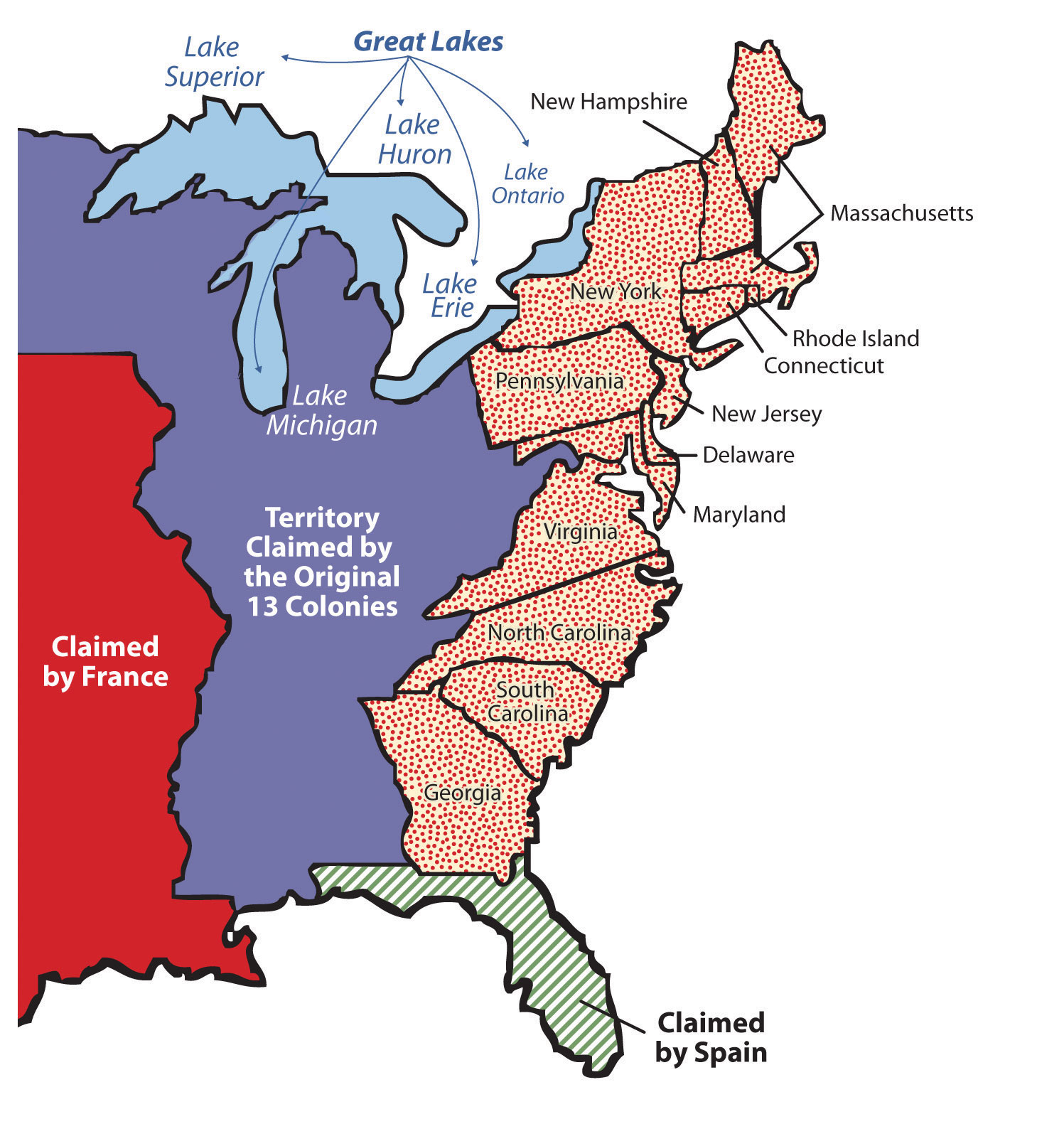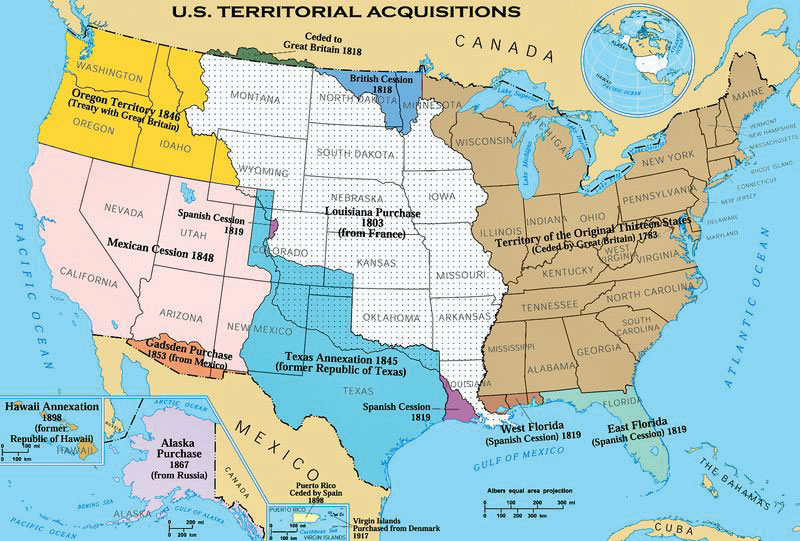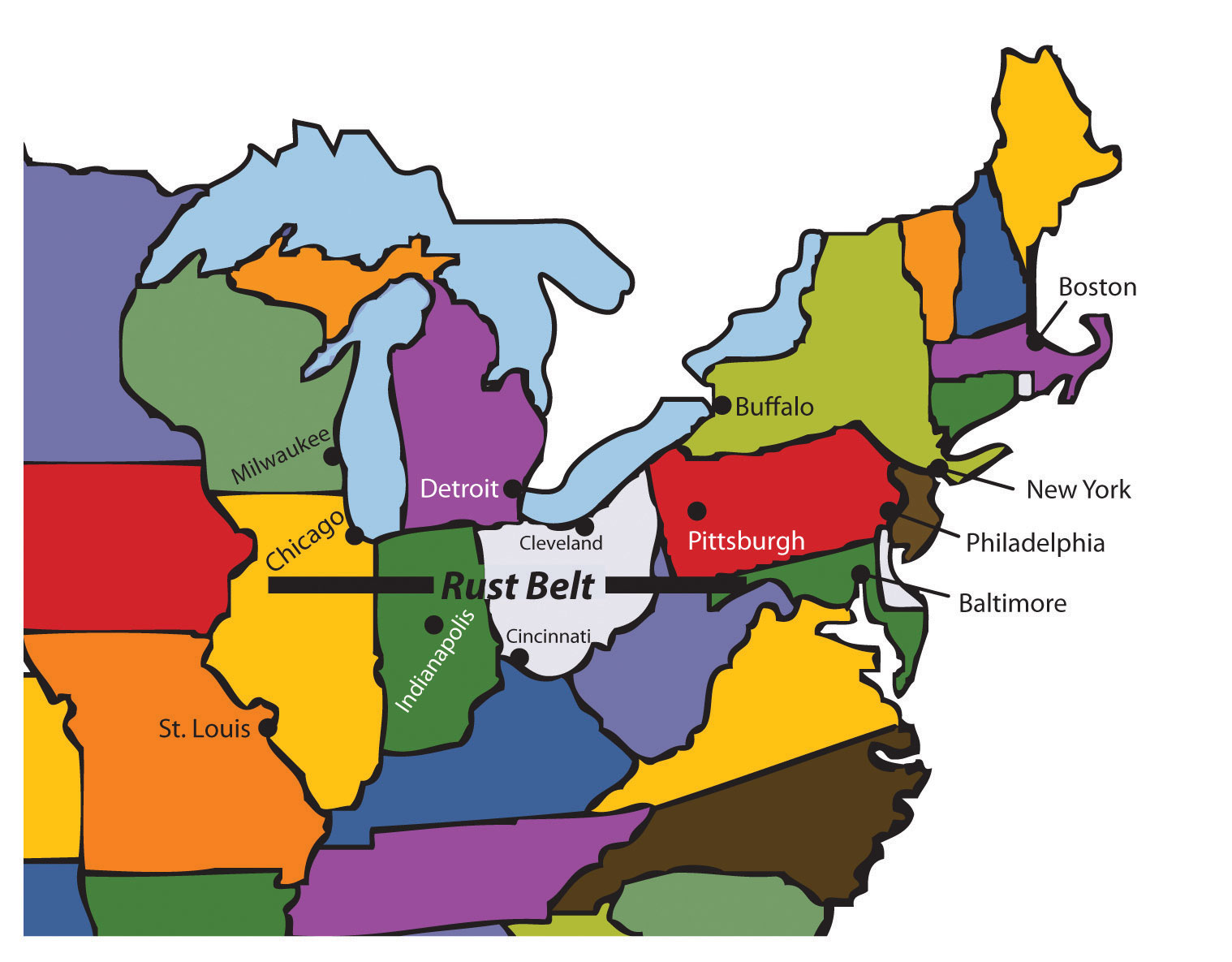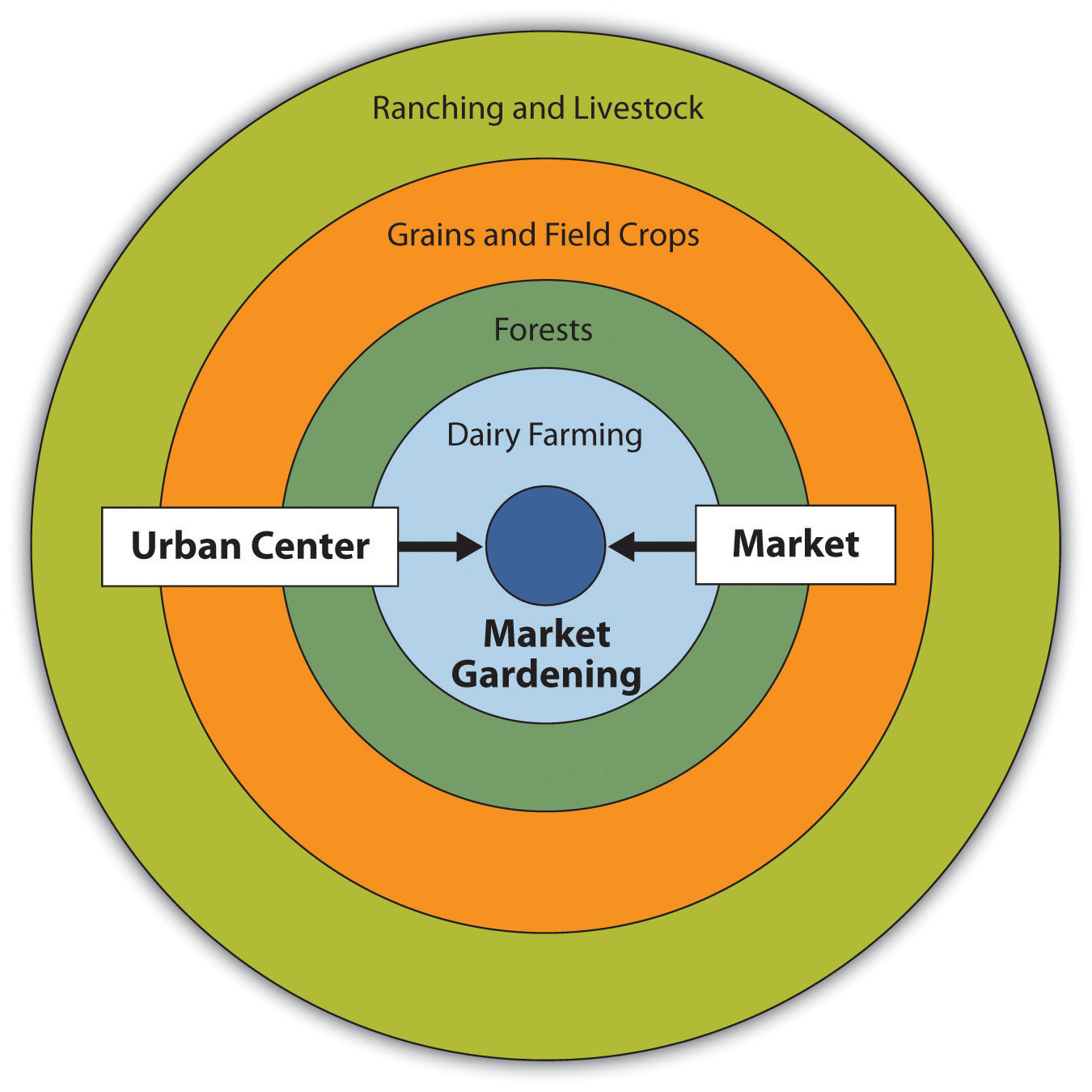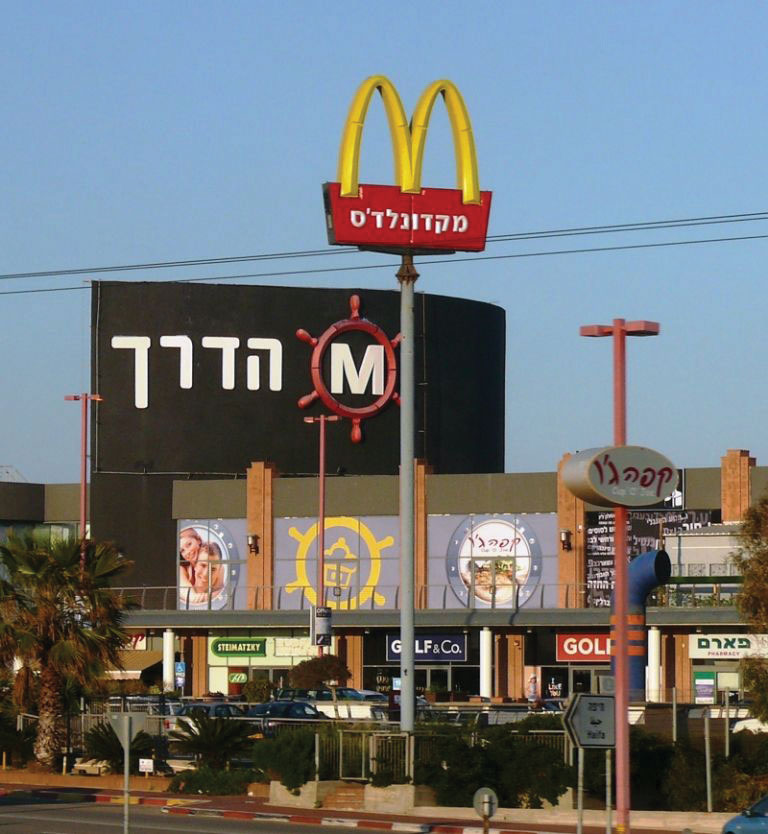4.2 United States: Early Development and Globalization
Learning Objectives
- Explain how the United States acquired its geographic boundaries.
- Examine patterns of immigration to and migration within the United States through the period of westward settlement.
- Examine urban growth and its connection to development of new forms of transportation.
- Explain which economic patterns helped the United States become the world’s largest economy.
- Consider how the concept of the American Dream has been exported globally.
Early Development Patterns
With abundant resources and opportunity, the original thirteen colonies prospered and expanded into what became the fifty US states. The political geography of this nation was a product of various treaties and acquisitions that eventually resulted in the country extending from the Atlantic to the Pacific Ocean. Fueling the expansion was the concept of Manifest Destiny: the belief of some Americans that the new nation was divinely predestined to expand across the continent. The United States negotiated with France for the Louisiana Purchase in 1803, acquiring millions of acres in the central United States (see Figure 4.5 “Geopolitical Map of the Creation of the United States from the Atlantic to the Pacific”). Florida was acquired from Spain in 1819, and Texas was annexed in 1845. The British sold portions of the Pacific Northwest to the United States, and the exact northern boundary between the United States and Canada was settled in 1846. Through conflicts with Mexico, large portions of the West were ceded to the United States in the mid-nineteenth century. Alaska was purchased from the Russians in 1867 for only $7.2 million. Alaska and Hawaii were the last two possessions to enter into statehood, which they did in 1959.
Figure 4.5 Geopolitical Map of the Creation of the United States from the Atlantic to the Pacific
Wikimedia Commons – public domain.
Manifest Destiny
The concept of Manifest Destiny came from the works of John O’Sullivan in 1839. O’Sullivan wrote,
As the United States developed, it acquired external colonial possessions. With victory over Spain in the Spanish-American War of 1898, the US government gained control of the Philippines, Cuba, Puerto Rico, Guam, and various Pacific islands. Cuba and the Philippines later became independent countries, but Puerto Rico and Guam continue to be part of the United States. The US Virgin Islands were purchased from Denmark in 1918 after World War I as a location to provide strategic military support to protect the shipping lanes through the Caribbean and the Panama Canal.
Westward Settlement Patterns and European Immigration
The thirteen original colonies are often grouped into three regions, each with its own economic and cultural patterns. These three areas—New England, the Mid-Atlantic, and the South—are considered culture hearths, or places where culture formed and from which it spread. The three regions were source areas for westward migration, and migrants from these regions carried with them the cultural traditions of their culture hearths. New England was characterized by poor soils, subsistence agriculture, and fishing communities and was the birthplace of North America’s Industrial Revolution. Its largest city was Boston. Settlers from New England traveled west across New York State and into the upper Midwest and the Great Lakes region. The Mid-Atlantic region, focused on Philadelphia, Pennsylvania, was known for its fertile soils, prosperous small-scale agriculture, and multinational population. Prosperous farming led to a vibrant economy and a robust network of towns and cities. People who wanted to migrate west from this region traveled down the Great Valley into the Appalachian Mountains and across the Cumberland Gap into Kentucky, or they crossed Pennsylvania and traveled west via the Ohio River valley. The heart of the South was Virginia, a region oriented around plantation agriculture. The South was overwhelmingly rural, and in time the bulk of its agricultural workforce consisted of slaves brought to the United States from Subsaharan Africa.
Westward migration was spurred along by the gold boom in California (1849) and by the completion of the transcontinental railroad (1869). The settlement frontier pushed westward during the course of the nineteenth century and was declared “closed” by the Bureau of the Census in 1890. This did not mean that settlers were spread uniformly across the continent by 1890; indeed, vast areas of the Great Plains and the mountain west remained sparsely populated by Europeans at that time. The Homestead Act of 1862 also encouraged westward migration by offering 160 acres of free land to households willing to move west. The continental United States had been organized into official states by the end of the nineteenth century, except Oklahoma (1907), Arizona (1912), and New Mexico (1912).
Most US residents at its founding in 1776 had roots in Great Britain, with large numbers from other northern and western European countries and many others from Africa (most of whom were slaves in the South). During the nineteenth century, migrants continued to immigrate to the United States as its economy grew, especially after the 1830s. Germans and Irish began arriving in large numbers, joining others from Britain and other countries, predominantly those in western Europe. As the century progressed, others from southern and eastern Europe, from countries such as Italy, Russia, and Austria, became the most significant stream of immigrants to the United States. The new arrivals were different from the early British immigrants: they practiced Roman Catholic or Eastern Orthodox Christianity (not Protestantism), they primarily moved to urban areas, and they found work in the new manufacturing sector growing rapidly in the Northeast and around the Great Lakes. Very few immigrants came from Latin America or Asia at that time.
Industrial Development and Urbanization
The Industrial Revolution that began in Great Britain in the late eighteenth century eventually moved across the Atlantic and took hold in the United States. Rapid industrial growth emerged in the nineteenth century and was focused in the northeastern United States around the Great Lakes in an area called the Manufacturing Belt (Figure 4.7 “Manufacturing Belt Turned Rust Belt”). Mechanized manufacturing began with textiles (New England), moved to steel and other metals (Pennsylvania and Indiana), and later was dominated by the manufacture of automobiles (Michigan). Of course, manufacturing would not have been possible without an abundant supply of power. Coal mining became an important industry in western Pennsylvania and in Appalachia.
Manufacturing took place in the cities and towns of the Manufacturing Belt. Not until the second half of the twentieth century did manufacturing move to rural areas; until then, it was almost entirely an urban activity. As the United States went through its Industrial Revolution, its population shifted from being almost entirely rural to being mostly urban. In 1790, only about 5 percent of the US population lived in urban areas; by 1920, about 50 percent lived in cities. As the rural to urban shift took place, the function and form of US cities also changed.
Table 4.1 US Population and Percentage Urban
| Year | Percentage Urban | Population in Millions |
|---|---|---|
| 1790 | 5.1 | 3.9 |
| 1810 | 7.3 | 7.2 |
| 1830 | 8.8 | 12.9 |
| 1850 | 15.4 | 23.2 |
| 1870 | 25.7 | 38.6 |
| 1890 | 35.1 | 63 |
| 1910 | 45.6 | 92.2 |
| 1930 | 56.1 | 123.2 |
| 1950 | 60 | 151.3 |
| 1970 | 73.6 | 203.3 |
| 1990 | 75.2 | 248.7 |
| 2010 | 82.0 | 308 |
Source: “The World Factbook,” Central Intelligence Agency, http://www.census.gov/population/censusdata/table-4.pdf.
From the colonial era until the late nineteenth century, US cities were walking cities. Because most Americans lived on farms, cities were small, compact, and centrally oriented: everything was located within walking distance. Only wealthy people had access to transportation by horse, and city dwellers needed to live within a short distance of where they worked, shopped, and carried out all their activities. The invention of the electric streetcar (1888) allowed cities to increase in size. People could live farther from their place of employment as long as they lived within walking distance of a streetcar line. Streetcar suburbs grew up along streetcar lines, and these neighborhoods were often segregated by ethnicity and race. Fewer people lived in downtowns, which became dedicated to retail and manufacturing. Cities remained oriented around a central business district (CBD), which was often located near the railway station. Factories needed to be near modes of transportation for both shipping in parts and shipping out completed products and so that workers could easily get to work.
Large numbers of middle class Americans began acquiring automobiles after about 1920; this eventually led to a complete rethinking of the spatial layout of the city. Automobile suburbs sprang up outside the traditional city limits as people were able to buy homes far from streetcar lines or railway stations. Cities became increasingly decentralized: people could go shopping in suburban malls instead of downtown department stores, factories could spring up at highway interchanges and not only near rivers and the railroad, and people could live in one suburb and work in another instead of living in the suburbs and working downtown. Neighborhoods became even more racially and economically segregated than they had in the past as middle-class whites moved into the new automobile suburbs and left the poorer African Americans behind in the cities.
By the late twentieth century, the automobile had led to a new urban form: the edge city. Edge cities are areas of dense urban development outside the boundaries of the traditional city. They often form at the intersection of major interstate highways and contain shopping malls, office complexes, high-rise apartment buildings, industrial parks, restaurants, and hotels. Sometimes edge cities are called suburban downtowns. Edge cities have supplanted the CBD as the destination of choice for Americans, whether they are heading to work or to play.
Economic Changes
For the purpose of understanding economic geography, all economic activities can be grouped into one of four categories, each with its respective terms, depending on the nature of what is being produced:
- Primary economic sector activities include everything that pertains to the collection of raw materials, such as agriculture, forestry, fishing, and mining—in other words, growing and extracting activities.
- Secondary economic sector activities involve the processing of those raw materials through manufacturing, which has been the mainstay of economic growth for most developed countries.
- Tertiary economic sector activities are those that produce services, not physical products.
- Quaternary economic sector activities are those that deal with information collecting and processing, as well as management.
The tertiary and quaternary economic sectors are often thought of together as the service sector. In the explanation of how countries gain national income (Section 1.4 “Globalization and Development”), only primary and secondary activities produce actual physical products, and manufacturing traditionally earns the highest value-added profits. Tertiary activities are selective in gaining national wealth. For example, service activities such as tourism can bring in national wealth if the visitors are from outside the country. Tourism within a country can also influence economic conditions by increasing the amount of consumer spending.
During the colonial era and into the nineteenth century, when the majority of Americans lived on farms and worked in agriculture, most economic activity in the United States took place within the primary economic sector. Today, the primary sector is still an important component of the US economy, but far fewer people are employed in it. For example, less than 1 percent of Americans make their living by farming, but agricultural output has continued to grow because of advancements in mechanization and the development of high-tech seeds, fertilizers, and pesticides. The United States has been able to export surplus agricultural output to other parts of the world. Fewer people work in coal mines than in the past, but because of new mining technologies and methods such as mountaintop removal, coal production remains high.
The geographic distribution of primary activities depends both on the location of natural features such as physical geography and climate and on the location of the market for a particular crop or resource. The nineteenth-century German economist Johann von Thünen created a model that predicted land use around a central market. In his theory, land closest to the market would be used to produce crops that were expensive to transport, such as dairy. Land far from the market would be used for the production of crops that were less expensive to transport and less perishable, such as grain. The von Thünen model predicts a series of concentric rings surrounding a central market, with each ring producing a different kind of crop. If the von Thünen model is applied at a much larger scale to the United States as a whole, with the densely populated urban zone from Boston to Washington, DC (called a megalopolis), used as the central market, the model does a fairly good job predicting the United States’ agricultural land use. Dairy farms are found close to the market, grain farms are farther away, and ranch lands used for livestock production are even farther away.
Figure 4.8 The von Thünen Model
The von Thünen model as it relates to the development west of the East Coast megalopolis. For example, New Jersey is called the Garden State, Appalachia has its forests, the Midwest has its agricultural production, and the Great Plains has its large cattle ranching operations. This model was more applicable in past centuries for local communities when modern transportation technology was not available.
Anything that involves the processing of raw materials—manufacturing—is a secondary activity. As the United States moved into the Industrial Revolution and into the mid-twentieth century, the percentage of the US workforce involved in manufacturing grew from almost nothing until it peaked in the late 1970s. It was the main area of economic growth for decades. Although manufacturing was present in most areas of the country, it was focused in the northeastern United States and along the Great Lakes. Factories were close both to the reserves of labor and to the markets for manufactured products found in the densely populated Northeast. The steel industry was located in Pittsburgh and its environs because of the area’s access to iron ore (mined in Minnesota and transported via the Great Lakes) and to coal (mined in Pennsylvania, West Virginia, and other parts of Appalachia).
As manufacturing has grown in other parts of the world, the secondary economic sector has declined in the United States. US labor statistics indicate that the United States lost about five million manufacturing jobs between 2000 and 2010 (Nance-Nash, S.). Many of these jobs were lost to countries with lower labor costs, such as Mexico or China.
The third group of economic activities takes place in the tertiary and quaternary sectors, commonly known as the service sector. Tertiary and quaternary activities create services, not physical products. Service jobs include everything from engineering to finance, restaurants to sports, and childcare to medicine. The tertiary sector makes up more than three quarters of the US economy, as measured by its share of the gross domestic product (GDP), which is the total value of all goods and services produced in a country in a given year. The GDP is then divided by the country’s population to provide a GDP per capita statistic. The 2010 estimated GDP composition by sector for the United States is shown in Table 4.2 “US GDP by Sector (2010 Data)”.
Table 4.2 US GDP by Sector (2010 Data)
| Economic Sector | GDP (%) |
|---|---|
| Agriculture | 1.2 |
| Industry and mining | 22.2 |
| Services | 76.7 |
Source: “The World Factbook,” Central Intelligence Agency, https://www.cia.gov/library/publications/the-world-factbook/geos/us.html.
These figures show that the United States has shifted to a postindustrial service economy. The rise of the information age in the latter part of the twentieth century shifted the workforce into the information sector. By the start of the twenty-first century, less than 2 percent of the US workforce was employed in agriculture, 15 percent in industry, and the rest in services (18 percent) and information activities (65 percent).
The locations of service-sector jobs are much more flexible than are jobs in the primary or secondary sectors. They are called footloose jobs: an accountant can live in New York or in Denver, whereas it is much more difficult for factories to move from one place to another and it is impossible for farms to relocate. Many of the information-technology jobs are emerging in the southern regions of the United States called the Sun Belt. Southern cities such as Atlanta, Dallas, and Phoenix are centers of innovation and population growth. The warmer climate, combined with a lower cost of living and less congestion, makes the Sun Belt an attractive location for emerging information-based companies. Note that the popularity of the South and West for service-sector jobs only came about after the invention and adoption of air-conditioning. Air-conditioning was not widespread until after the Second World War in the 1950s.
While the population of the Southern states has increased, the population of some Northern states has decreased. The Sun Belt has always been a destination for people escaping the harsh winters of the Northern states. This has usually been only a seasonal transition. However, the new trend is one of permanent growth because of the increase in information technologies and in the service industry. Emerging companies looking to establish their businesses have targeted major cities from the Carolinas to the Southwest.
Migration Patterns
The United States has not only undergone a massive rural-to-urban shift in its population; intermigration within the United States from one region to another has also been prevalent. Each of the US regions has witnessed changes in demographics because of migration patterns.
In the agricultural regions of the United States, such as the Midwest, the migration pattern has been caused by changes in farm technology. Portions of the United States were opened up for agriculture because of the Homestead Act of 1862, where each person could receive 160 acres from the government to start a farm. They could keep the acres if they lived on them and farmed them for a period of years. In the 1800s, 160 acres was enough land to support a family if conditions were appropriate. The Industrial Revolution brought about improved farm equipment and technology. Larger and more expensive tractors and improved farming methods pushed the small farmers to sell out. Farms increased in size and fewer people were required to operate them. Since fewer farm workers are needed in rural areas, there has been a major rural-to-urban shift in the population. Central cities are increasing in population, while small towns and rural areas in the Midwest and across the nation are decreasing in population.
Americanism and Globalization
The freedom of personal expression in the United States has supported individual ingenuity and creative ambition to create the largest economy in the world. US citizens have pushed American corporations to become a major force in the world markets. Products and franchises from the United States are being distributed throughout the world. Items such as fast food, computers, news networks, and Hollywood movies have become the products of choice in countries across the globe. The English language dominates the Internet, which has been heavily influenced by US corporations. The power of the American Dream—the idea that through hard work anyone can achieve upward mobility and financial success—as it is portrayed in the US media holds sway in the minds of people both in the United States and abroad.
US news networks, such as CNN, are so dominant that small countries, having no resources to create networks, rely on the US networks to deliver their world news. US fast food franchises, of which McDonald’s is the largest, exist in over one hundred countries. Despite humble beginnings in Arkansas, Walmart grew to become the world’s largest corporation. It has become the buyer and seller of retail trade that shapes and molds cultural attitudes and fashions internationally.
The size of the US population (more than 310 million strong as of 2010) and the country’s vast resource base have allowed it to become a world military superpower. After the fall of the Soviet Union, the United States became the most powerful military force in the world. The United States has also dominated the world’s economy and its communications networks. The advancements of multinational corporations have in essence enabled the sale of America to the rest of the world. The selling of American products and the large consumer market in the United States have provided the profits that have fueled global economic markets.
The United States has become a worldwide franchise of its own. Corporate colonialism has advanced the American brand to a level that is now synonymous with consumerism, success, and power worldwide. Media advancements have promoted the concept of the American Dream across the seven seas. The reaction of the global community includes both admiration and disdain. Many view Americanism as interchangeable with globalization. Some welcome it; others reject it. The country of Iran is an example of this dichotomy. Young people in Iran wearing blue jeans gather in secret to watch American television programming from a hidden illegal satellite dish, while at the same time the anti-American forces in their government condemn America as decadent, immoral, and imperialistic.
Corporate colonialism has become a dominant force impacting the global cultural fabric. Supporters appreciate access to American goods and services, while opponents claim that the English language and the American corporate franchise system are destroying the culture and heritage of untold millions who see their unique traditional ways of life being overshadowed and destroyed.
Some argue that American television advertisements exemplify a trend that supports conformity and uniformity in American culture. They contend that America’s unique cultural diversity, which historically has provided ingenuity and creativity, is being eroded by the franchising of similar retail products, fast food, professional sports, and Hollywood entertainment that stifle the creative will of the American people. Others continue to see opportunities to pursue the American Dream and believe that innovation and ideas continue to emerge in spite of these trends.
Many people worry about the future of the American Dream. American culture continues to evolve as people face changing economic and social conditions. Over the course of their history, Americans have faced both difficult and prosperous times, and now the future of this vibrant country is in the hands of the current generation. The United States has developed into one of the most powerful countries on the planet. Will the American Dream continue to motivate people in the future? Only time will tell.
Key Takeaways
- The United States’ territory expanded gradually through various treaties and land acquisitions and was influenced by the concept of Manifest Destiny.
- The three main colonial regions in the United States—New England, the Mid-Atlantic, and the South—had their own distinct economic foundations, settlement patterns, and social structures. People from these regions moved westward in particular migration patterns.
- In the beginning of the nineteenth century, most immigrants were from western and northern Europe. By the end of the nineteenth century and the beginning of the twentieth century, immigrants were coming in large numbers from southern and Eastern Europe and moving to industrial cities of the Northeast.
- City structure changed from the walking cities of colonial America, to the railroad and streetcar cities of the late nineteenth century, to the automobile cities of the mid- and late-twentieth century.
- The US economy was initially based in the primary economic sector (particularly farming), then was based in the secondary economic sector (manufacturing), and is now oriented around the tertiary and quaternary economic sectors (services and information).
- The diverse immigrants who have created American society have been unified by common aspirations and common ideals that created the concept of the American Dream. The concept indicates that regardless of one’s station in life, by working hard, applying oneself, and following the rules, one can obtain upward economic mobility.
Discussion and Study Questions
- What did “Manifest Destiny” mean for the United States?
- What European region did most early nineteenth-century immigrants come from? How did that change by the end of the nineteenth century?
- How did modes of transportation affect the layout of American cities?
- What is an edge city, and how did edge cities form?
- How does the von Thünen model relate to the spatial pattern of land use in the United States?
- How have economic sectors shifted in the United States in the past two hundred years?
- What is the American Dream, and how has it been expanded globally?
- What has been the major migration pattern in the Midwest region of the United States? Why is this occurring?
- What part of the United States has been a target for the location of information age–based businesses? What was the role of air-conditioning technology in making this possible?
- Outline some examples of how US culture influences the rest of the world.
Geography Exercise
Identify the following key places on a map:
- Cumberland Gap
- Great Valley
- Manufacturing Belt
- Midwest
- Original thirteen colonies
- Sun Belt
References
“John L. O’Sullivan on Manifest Destiny, 1839,” http://www.mtholyoke.edu/acad/intrel/osulliva.htm.
Nance-Nash, Sheryl “‘Made in America’ Leaders That Really Make a Difference,” Daily Finance, http://www.dailyfinance.com/2011/07/01/made-in-america-leaders-that-really-make-a-difference/.

